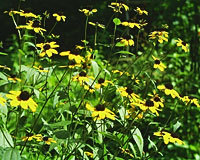What’s in a name? Quite a lot, actually — and when you study some of the common names of wildflowers, you find out just how unusual many of them are.
The common name for the daisy (Bellis perennis), for example, is derived from the Anglo-Saxon “daeges-eage” (“eye of day”), because the flower head closes at night but opens again during broad daylight. The generic “Bellis” could be linked with the Latin “bellum” (meaning “war”), because for centuries this perky little plant has figured in herbals as a cure for wounds and various battlefield ailments. But it could equally well come from the Latin “bella” (“pretty”). The species name, “perennis,” refers to the plant’s perennial nature.
Or consider the dandelion. Because of their tendency to appear where they’re not wanted, dandelions are immediately removed from lawns and flowerbeds. Yet if they were less ubiquitous, these handsome, golden blossoms with stems sporting jagged leaves would be much sought after by gardeners. In his poem “To the Dandelion,” James Russell Lowell wrote:

photo courtesy Organic Gardener School
Rudbeckia hirta: The black-eyed Susan, gloriosa daisy or yellow oxeye daisy is the commonest wildflower in this country.
|
“How like a prodigal doth nature seem
When thou, for all thy gold, so common art!”
The name dandelion (Taraxacum officinale) is said to come from the French “dent de lion” (“lion’s tooth”). And though some believe this refers to the toothlike appearance of the flower head or the taproot, it almost certainly alludes to the backward-pointing, fine-edged lobes of the somewhat bitter-tasting leaf. The French term is itself drawn from the Latin “dens” and “leo” (again referring to the dentate or toothed foliage).
Another, smaller feline is remembered in the plant we call catnip (Nepeta cataria) — or, in England, catmint. Cats absolutely adore this plant — Kubin and Manet, our cats, are so keen on the scent that they deliberately bruise or nip the stems to release the perfume. An ancient belief holds that cats crave this vegetation, and whenever they smell or sample it, they immediately turn very affectionate, sportive and “full of fight.” The plants were first discovered at Nepet in Tuscany.
During the reign of Elizabeth I, the ruffs and frills that marked the day’s fashions were stiffened with a pure, white starch made from cuckoopint root (Arum maculatum). The common name for this plant (which is similar to our jack-in-the-pulpit) refers not to the bird but to the Anglo-Saxon “cucu” (meaning “lively”) and “pintle” (a word for “a perpendicular pin,” descriptive of the outline of the spiked blossom). And when those ruffled collars got soiled, the foliage of soapwort (Saponaria officinalis) was used to clean them. When boiled or bruised in water, the leaves turn saponaceous, and the resulting lather cuts through grease. (The Latin “sapo” means “soap.”) “Wort” was once favored as a synonym for “plant,” much as the term translated as “lily” has been used in several Oriental languages to mean simply a “dainty flower.”
Goutweed (Aegopodium podagraria) is a terrible weed; beware the variegated type now pushed by many nurseries as a ground cover. This plant was once used to relieve the pains of gout, a complaint fairly common among the Church hierarchy — hence its other common name, bishop’s weed. “Aegopodium” stems from the Greek “aix” (“goat”) and “pous” (“foot”), from a supposed similarity of the leaf form. As for “podagraria,” it means “cure for gout.”
[Peter Loewer, aka The Wild Gardener, is a regular contributor to Xpress.]



Before you comment
The comments section is here to provide a platform for civil dialogue on the issues we face together as a local community. Xpress is committed to offering this platform for all voices, but when the tone of the discussion gets nasty or strays off topic, we believe many people choose not to participate. Xpress editors are determined to moderate comments to ensure a constructive interchange is maintained. All comments judged not to be in keeping with the spirit of civil discourse will be removed and repeat violators will be banned. See here for our terms of service. Thank you for being part of this effort to promote respectful discussion.